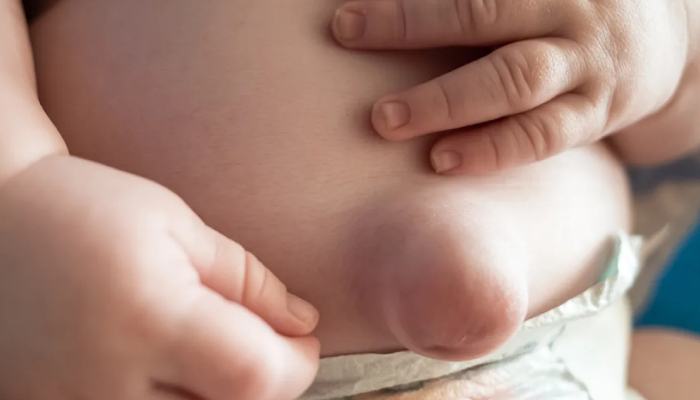My baby’s belly button looks larger than it should…
You’re probably worried that your child’s belly button sticks out. You’ve noticed that it even bulges when your baby cries, coughs or strains to poop. If that’s the case, your baby has one of the most common conditions of childhood called an umbilical hernia. 10 % to 20% of all children have an umbilical hernia.
Why do umbilical hernias occur?
When the baby is in the womb, a small opening in the abdominal muscles called the umbilical ring allows the umbilical cord to pass from the baby’s abdomen to the mother. After birth, as the cord dries up and falls off, the muscles grow to close off the umbilical ring. Sometimes, this growth does not occur in time and the ring remains open although the cord has fallen off. This allows fluid, fat or bowel to protrude through the defect when the baby strains and form a bulge under the skin. Except under certain circumstances, this bulge is not painful.
Should I be worried?
All is well as long as the umbilical hernia reduces when the baby relaxes. Very rarely, the bowel or fat entering the umbilical ring gets stuck or incarcerated. In such a situation, you need to contact your doctor immediately. If the baby becomes constipated or begins to vomit, you would do well to report to the emergency room. However, such occurrences in infancy are extremely rare.
Does it need to be fixed?
About 80% of umbilical hernias resolve spontaneously by the age of 3 to 4 years. As I mentioned earlier, it is exceedingly rare for umbilical hernias to complicate during infancy. Hence, in a baby these hernias can safely be observed. However, umbilical hernias that persist beyond the age of five years are more likely to incarcerate or rupture. Hence, if an umbilical hernia persists beyond infancy, a decision needs to be made about surgery.
Will the belly button look normal after surgery?
Umbilical hernia repair is relatively straightforward and can be done as a daycare procedure for children who have no other medical conditions. Your surgeon will reconstruct the umbilicus in the same surgery.
If the hernia is small and the amount of redundant skin isn’t much, your surgeon might simply tuck the skin at the umbilicus and allow it to remodel itself. If the amount of redundant skin is greater, your surgeon will need to perform a more elaborate procedure called an umbilicoplasty. Eventually, your child should have a normal looking umbilicus.
What should I be concerned about after the surgery?
Contact your doctor if your child has:
- Redness at the surgery site
- Fever
- Bloody, foul, or sticky fluid from the surgery site
- Constipation
- Abdominal distension
- Vomiting
- Excessive pain that does not go away with the prescribed painkiller.


